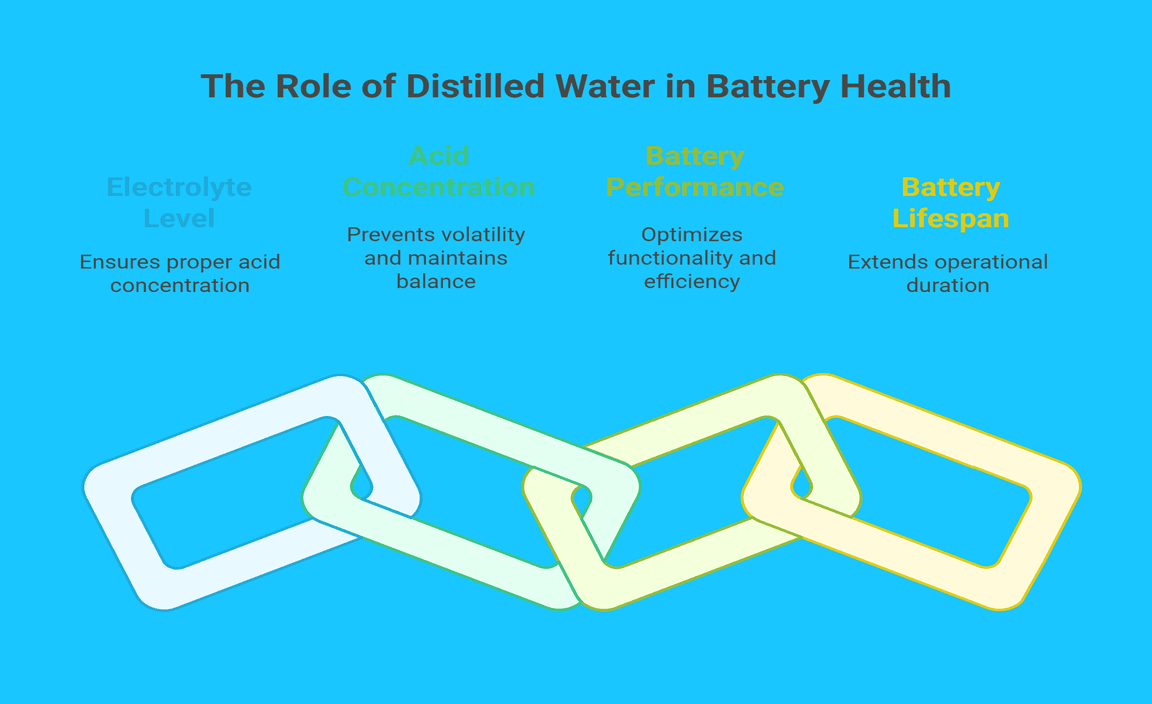Proper maintenance can stretch the lifetime and efficiency of your lead-acid battery. Out of many ways of maintenance, keeping the water level in check is the first and foremost thing and the simplest way of maintenance that needs to be done. And when it comes to filling water in your battery, confusion can be created over distilled water vs battery acid.
But the confusion can be alleviated with proper knowledge of both battery acid and distilled water and their formulation and effect on the electrolytes.
In this article, we will provide you with all the insights to help you decide which one to pick for proper battery maintenance.
Formulation Of Electrolytes
In a lead-acid battery, the negative and positive plates are dipped into a liquid formulation that is called electrolytes. This electrolyte is a mixture of water and sulfuric acid in diluted form. Both the liquids are mixed together in 5:3 formation to make the acid less volatile.
When you recharge your battery, the battery consumption diminishes the level of electrolyte that needs to be filled as early as the next battery consumption. As the formulation includes both acid and water, confusion may arise while filling the electrolyte level regarding which one to put into the chemical solution.
What Is Battery Acid?
Battery acid is a kind of acid used in a lead-acid battery that helps to formulate electrolytes. In that case, sulfuric acid is mostly used for all lead-acid batteries. The acid mainly provides electrolytes in the battery. It must be mixed with water to reduce its concentration level that keeps the acid in a less volatile state. Battery acid is the main element that is responsible for the chemical reaction that exerts negative and positive electrons. Battery acid can be very dangerous wherever it spills. Therefore the user must be aware while dealing with it.
What Is Distilled Water?
Distilled water is a type of water that goes through a demineralisation or distillation process to get rid of minerals and other substances from the water making the water deionized. Normal tap water contains a lot of minerals that adversely affect the lifetime of the battery. Minerals in the water get separated when mixed with sulfuric acid and create bubbles in the water and acid solution. This can, later on, be a constraint for chemical reaction and electrochemical processes in the battery.
The process of making distilled water is very simple. First of all the normal water goes through a filtration process. Then, you must add a coagulant into the filtered water. After that, another filtration process should be conducted. Lastly, the water will be boiled and the steam will be collected by cooling it in a closed system.
When To Use?- Battery Acid Vs Distilled Water
The use of distilled water or battery acid both are considered when the electrolytes level drops. Keeping the electrolyte level in a way where both the positive and negative plate is immersed is mandatory for the lead-acid battery to function properly. In that case, distilled water should be used to refill. Because when the electrolyte level drops, it means the water has been diminished from the acid and more water is required to enable the chemical reaction.
So distilled water should be used whenever you detect that the fluid level drops.
But, when can you use battery acid? Basically, battery acid contains the electrolytes that cause the conversion of chemical reactions to electronic reactions. Acid is highly volatile and to reduce its volatile state water is used. But you can not pour more acid into the battery fluid when the level of the electrolyte drops. Because excessive battery acid will damage the positive and negative plate and the battery will not function properly in terms of producing power for battery-powered equipment.
Battery acid can only be used when the water solution is contaminated with minerals or dirt that will likely affect the chemical reaction. In that case, the entire solution should be replaced. In addition to that, you are allowed to pour acid into the solution when the electrolyte level is only left on the bottom surface meaning drops to the lowest level.
Why Distilled Water Is So Important For Lead-Acid Battery?
What happens to us when our body is dehydrated? Simply, we feel weak and can not concentrate on any task for lack of water in the body as it lessens the physical functional ability. The same happens with a lead-acid battery as it too gets dehydrated after a few recharges.
When the level of the electrolyte gets lower and the plates are exposed, pouring water is mandatory for reducing the acid concentration. In absence of adequate water, the acid gets concentrated and becomes more volatile. Distilled water in that case is necessary for optimizing the performance and long life span of the battery by restoring the concentration of the sulfuric acid.

Frequently Asked Questions (FAQs)
Is Battery Water The Same As Distilled Water?
Battery water and distilled water are never the same. Battery water has sulfuric acid at 4:1 water and acid ratio. On the other hand, distilled water is just pure de-mineralized water. For your easy understanding, battery water is an alternative name for battery acid. It can be found in any chemical or electronic retail shop as a readymade electrolyte solution.
How The Sulfuric Acid Should Be Mixed Into The Water?
Most beginners make a serious mistake regarding mixing water and sulfuric acid. What they do is, they mix water into the acid whereas they are supposed to do vice versa. Because when you pour water into the acid, it creates a dangerous reaction. On the other hand, if you pour the acid into the water slowly, the reaction will be normal and safe.
Conclusion
Battery acid and distilled water are the two distinct components that formulate the electrolytes in the lead-acid battery. Plus, battery acid contains electrolytes and distilled water is used to reduce the acid concentration to minimize the volatility of the acid.
In fact, battery acid is nothing but sulfuric acid and distilled water is minerals and metal-free water that goes into the lead-acid battery with the sulfuric acid to create the electrochemical reaction that breaks the electron from the chemical reaction.
Hope this write-up satisfies your cravings for this topic. Good Luck.
Resource:
- Understanding Electrolytes in Batteries: https://www.sciencedirect.com/topics/engineering/electrolyte
- Dangers of Sulfuric Acid Handling: https://www.cdc.gov/niosh/npg/npgd0600.html
- Benefits of Using Distilled Water in Electronics: https://www.explainthatstuff.com/distillation.html
- Lead-Acid Battery Maintenance Tips: https://batteryuniversity.com/article/bu-804b-sulfation-and-how-to-prevent-it




